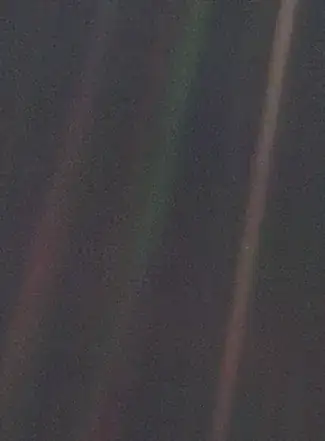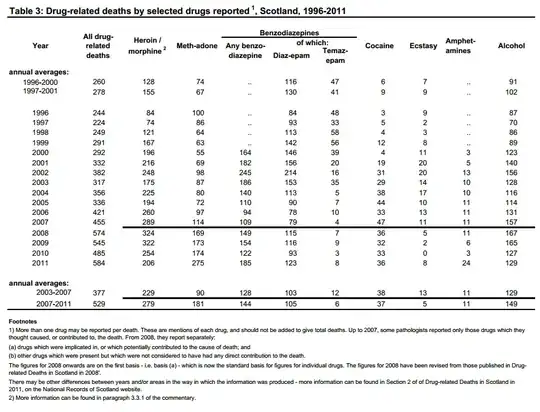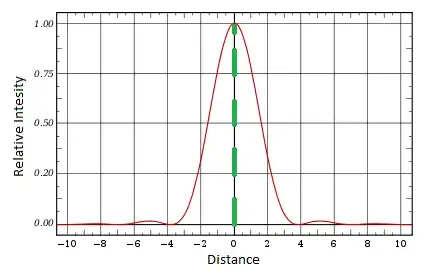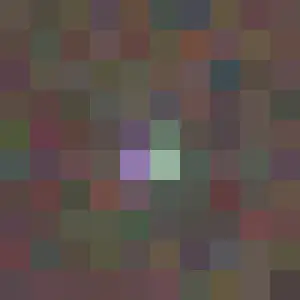The Earth in the famous Pale Blue Dot image (below) is claimed by NASA to be "0.12 pixel in size". How can something be visible on a digital screen which is smaller than a pixel (or sub-pixel, which is still only a third of a pixel)?

The Earth in the famous Pale Blue Dot image (below) is claimed by NASA to be "0.12 pixel in size". How can something be visible on a digital screen which is smaller than a pixel (or sub-pixel, which is still only a third of a pixel)?

The image was taken 4 billion miles from Earth, according to NASA. The camera is a narrow-angle camera, with the following specifications:
The Narrow-Angle camera optics is a 1500mm diameter focal length all-spherical, catadioptric cassegrain telescope (a modified MVM 1973 design) consisting of five elements plus an additional dust lens located between the shutter and the vidicon. The f stop number is 8.5. (VGR ISS Calibration Report, 1978, an internal JPL document available from JPL vellum files). [source]
Assuming the image is not cropped or scaled in any way (325x441 pixels)...
4 billion miles away is about 6.44×1012 meters. Now, techically, the 1.5m telescope compared to 6.44×1012 meters is virtually nothing. What we can do is work out what the field of view would be at Earth. Assuming the Earth is truly 0.12 pixels, that would make 0.12 pixels approximately 12,735,000 m, or the entire image about 3.44×1010 meters across. (At the distance of Earth.)
At 6.44×1012 meters away, this would make the camera's FOV cos-1(3.44×1010 / 6.44×1012), or about 58 degrees. For a narrow angle lens, this sounds about right. Anyone want to verify my trig? I've probably made a mistake somewhere.
How can we take an image of something that is less than 1 pixel ?
Because telescopes (optical systems) record images of energy functions not objects.
Telescopes, image sensors, and the human eye sense photons at various energy levels. If the photon is within the device's detectable frequency/energy range it will be recorded. The size of the object that produced the photon is immaterial.
Take my user icon for example... It is an image of the Jellyfish Nebula taken on a 0.37m (14.5") Ritchey-Chrétien with a monochrome 4096 x 4096 CCD. The width of the nebula here is ~50 light-years and it is 5,000 light-years from Earth. The angular diameter of the full-moon is ~32.0 arcminutes. This image is 37.8 arcminutes square and is a combined average of eight 20 minute exposures. The Voyager image is a combination of three exposures (I could not find the details on durations). Given the scale and exposure details, consider the size of stars in the image and detail.

From Voyager's point of view consider Earth as one of the stars in the image...
[A] star’s image is not a point, but is the point spread function of the lens viewing it. This function will depend on the diffraction limit of the aperture, and the aberrations of the optics, but usually has most of the energy localized at the center and then trailing “skirts” farther away.

If we are recording an object with a "perfect" detector then our image would be identical to the original point of light. So if the relative intensity of this point of light were plotted as a function of distance, on the detector surface, such a plot would look like the dashed, vertical, green line.
But none of our detectors are perfect so the relative intensity of the point of light is distributed across the detector as shown by the red curve. This curve is called the "point spread function" (PSF).
The behavior of film is to convert to metallic silver those areas that are exposed with enough energy to exceed a certain threshold level. Because of this, brighter stars, having a higher amplitude point spread function, will make a larger recorded spot. The relationship is not proportional, but depends on the details of the point spread function of the system, and the energy threshold of the film.
...or detector of your choice.
The Bottom Line...
Given position of Voyager, the instrument used and Thomas O's math (brilliant btw), the "image scale" size of Earth is indeed ~0.12 pixels.
Quoted Source: The Colors of the Stars
Each pixel records the sum of all the light from the objects that fit within the area covered by that pixel.
If some small fraction of that area is very bright, then it will contribute more than its fair share to the sum of the light covered by that pixel and make the whole pixel appear brighter.
In this way, a small item 0.12 of a pixel across can make the whole pixel be bright - but not as bright as if it took up the whole area covered by the pixel.
(I am going to be pinged for not providing references again, but this just comes from an understanding of digital photography.)
Diffraction limited size aside, it appears that the earth lights up 3 to 4 pixels in the large tiff format NASA image:

Either diffraction limit/airy disk or tracking instability could be responsible for the spread.
RGB (decimal) values of central 4 pixels are (clockwise from top left)
100 82 106
100 119 104
150 180 158
145 119 172
The background has a reddish cast averaging 100 86 83
While "pale GREEN dot" seems slightly more accurate than "pale blue dot", once you start subtracting background, you can get a nice variety of greens, turquoises and blues as possible color descriptors for our tiny world.